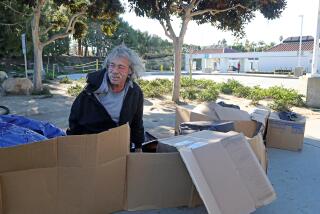Quality of Parkland Matters Most Under Strict Anaheim Law
- Share via
ANAHEIM — How do you make sure your town gets from developers the amount of flat, usable local parkland residents deserve?
That was the question confronting Christopher K. Jarvi soon after he took over as this city’s director of parks and recreation. His answer? Enforce consistent, unambiguous standards--no matter who the developer or what the project.
Responding to residents who were outraged at being stuck with scraps of steep, unusable parkland adjoining neighborhoods in Anaheim Hills, Jarvi won approval in 1988 of a local-park law that was quite specific:
It requires developers to dedicate 2 acres of parkland for every 1,000 new residents to be generated by their projects. The acreage requirement is actually low--most cities and counties in California require at least 2.5 acres per 1,000 residents. But for Anaheim, it’s the quality of the land that matters most.
The city was already loaded with park acreage, but too much of it was of the unusable-slope variety. No more, say planning specialists, who regard the Anaheim ordinance as an enviable model.
The new Anaheim ordinance strictly prohibits giving developers any park credit for dedicating land with a slope of 20% or more. (Flat land has a 0% slope; vertical land has a 100% slope.) Developers get only partial credit when they give land with slope of 6% to 20%.
The purpose of those requirements, the Anaheim ordinance explains, is to “ensure that (developers) provide local parkland which is typically land needed for active recreation rather than for passive recreation purposes.”
Said Jarvi: “There’s no debate as to what we’re going to get.”
Without the explicit standards, he said, developers would have more incentive to bypass staff professionals and to lobby office holders.
“They’ll try everything in the book--and do,” Jarvi said, adding that he has enjoyed firm backing from the Anaheim City Council.
Jarvi, a past president of the California Park and Recreation Society, said clear, unyielding standards are essential to obtaining adequate, usable local parkland.
Otherwise, “you’re going to get into battle,” Jarvi said. “And it’s going to end up in the political arena. . . . In the heat of battle, you can’t be defining what the standards are.”
Interviews with local government planning and parks specialists found that the word is out in Orange County and elsewhere in Southern California: Vigilantly control parkland dedications or look forward to decades of local-park shortages along with the costs of having to maintain misshapen bits of land unusable for playing ball or strolling a child.
In Mission Viejo--a community with a number of sizable, impressive park facilities--officials nevertheless found other parklands of dubious value. Of 14 such oddly configured parks, encompassing 98 acres, less than one-fourth of the land was determined to be “usable.”
The Mission Viejo City Council in March reacted to the findings by voting to demand “clear standards and guidelines . . . to ensure there is usable parkland.” Without those guidelines, said city Planning Director Clint Sherrod, “you can get property you can’t use.”
Another community hoping to avoid the misfortune of others in the county is the city of Orange, which is headed toward passing its own park-dedication ordinance, according to Planning Director Vern Jones.
“We’re not interested in acquiring a lot of drainage easements or utility easements” as parkland, Jones said. “There’s plenty of examples around the county where those kinds of easements have been used for parks. We really want the land we’re getting to be usable.”
For their part, many developers say that they, too, have a genuine interest in providing ample, quality local parkland.
Said Frank Foster, a board member of the Orange County Building Industry: “Builders really are interested in providing a quality of life in the communities we build in. Parks are definitely a part of that.”
Moreover, the problem of obtaining flat, usable parkland is not confined to Orange County. In neighboring San Diego County, where developers are required to dedicate 3 acres per 1,000 new residents, difficulties also have arisen, according to Noel Parr, the county’s chief of park development.
“Really, local parks should be level and usable to the total extent,” Parr said. “But it can be very difficult. The developer is looking at it from a cost-benefit standpoint. We’re looking at it on the basis of the long-term use.”
When unusable land has been accepted for parks in San Diego County, Parr said, it usually has resulted from decisions “at the political level.”
“It’s happened on a few occasions,” Parr said. “It’s really not at the staff level, but at the Board of Supervisors, or Planning Commission. At the political level, some kinds of arrangements are negotiated at the last minute.”
More to Read
Sign up for Essential California
The most important California stories and recommendations in your inbox every morning.
You may occasionally receive promotional content from the Los Angeles Times.










